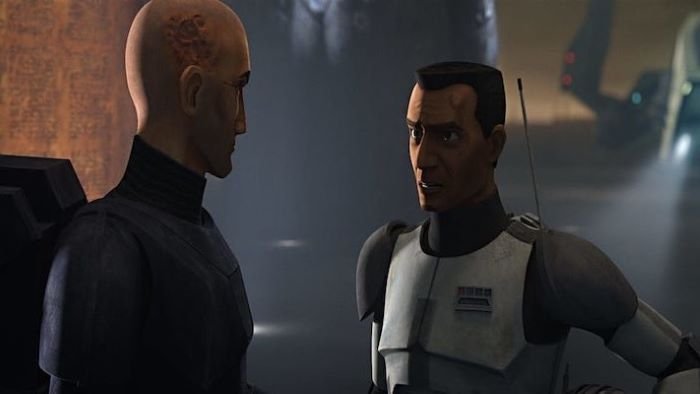What Are 'Filler Episodes' And Are They Necessarily Bad?
Image Source: Tower of Babble Podcast
WARNING: POSSIBLE SPOILERS FOR THE BAD BATCH SEASON 2 AND THE LAST OF US
“That was just a filler episode.”
This issue inevitably comes up in discourse about a television show. It is typically after an episode that has some or all of the following qualities: slow-paced, no action, lots of dialogues, no real tension or conflict, doesn’t seem to work with the larger story, or it is about a side character and the main character(s) are nowhere to be found. It is a common feature in the anime genre, originally meaning anything in the series that was not in the manga source material. Without the episode, the overarching narrative does not suffer and is just as likely forgotten. Since the 2007 writer’s strike, there has been a noticeable improvement in television writing. Seasons are shorter, forcing writers to be more concise and focus on the story rather than drawing out a season’s scheduled run with episodes that don’t further the narrative. The old television formula of long seasons with “monster-of-the-week” episodes had mostly gone by the wayside.
However, filler episodes are not completely gone. Star Wars animated shows and regular, broadcast sitcoms are notorious for this. The Clone Wars would stretch the storyline and frequently do these three-episode mini-arcs, and then resolve the overall plot at the end of the season. It is still a common sight in broadcast media sitcoms, like in The Big Bang Theory, or Call Me Kat.
A simple google image search for “filler episodes” brings pages and pages of Naruto images.
Image Source: CBR
RELATED:
The concept of filler episodes often carries a negative connotation. From a personal perspective, perhaps it feels like the viewer’s time was wasted. Critically speaking, the “crime” of a filler is it does not really move the narrative along. A lot of writing advice out there will often include this little tip. Editors will cut things that don’t move the narrative along. Think Chekhov’s gun, but for television.
But, is it necessarily a bad thing? Filler episodes are a mixed bag because there are some exceptions that come to mind that raise important questions. If there is an episode that seems to fall within the scope of what someone would call a filler, does it count against it if it is really well done, or entertaining? A couple of recent examples bring this question to the forefront of the discussion.
The last few episodes of Season 2 of The Bad Batch have seen a return to the common trope of the earlier Star Wars animated shows. The first season did not have quite a lot of these types of episodes, with the clones trying to make sense of the changing landscape with the new Empire. But in this season, after a stellar first two episodes that set the overall tone and scope of the season, they are followed with three episodes—so far—that deviate from the anticipated setup of the first two.
However, one of those episodes was particularly phenomenal. “The Solitary Clone” told a story entirely separate from the main characters, focusing on their former teammate Crosshair. It had fantastic character development, closely following his time with the Empire after the destruction of Kamino. Crosshair was sent on a mission with a former brother-in-arms, Commander Cody, where by the end of the mission, the gravity of the Empire’s methods drove a wedge between the two men. One of the last scenes was Cody walking away from Crosshair, and then he discovered that Cody went AWOL. It drove home the increasing isolation he was going to experience because of his decision to stay loyal to the Empire.
Cody and Crosshair in ‘The Solitary Clone.’
Image Source: StarWars.com
This episode stood in stark contrast to the episodes that followed. The next episode “Faster,” deviated further from the momentum of the first two with a side-quest style story following Wrecker, Tech, Omega, and Cid to a race track with all the nostalgia of the podraces from The Phantom Menace. This one was close to a pure filler episode, but there was an allusion to a darker history for Ci could be a threat to the clones later on. Then a purer filler episode followed that did not further the narrative that was set up in the first two episodes. While we learned more about Phee Genoa, she was already introduced in an earlier episode and came across as inconsequential. The Batch did not even get what they came for. Some viewers felt cheated out of their time, especially with the many questions and anticipation the end of Season 1 left on fans’ minds.
Another example comes from the recent episode of The Last of Us. After two near carbon-copy episodes compared to the games, the third episode took an off-hand, heavily implied line from the first game and turned it into an entire episode. The main characters were barely in it, and it mostly focused on Joel’s “friend” Bill and his partner Frank. It was one of the most incredible hours of television, masterfully written and acted, but it fits the definition of a filler episode.
Emmy-worthy performances from Nick Offerman and Murray Bartlett in The Last of Us.
Image Source: Deadline
Since the aforementioned The Bad Batch and The Last of Us episodes may technically qualify as filler, does that make them less in quality, despite their high ratings? Bill and Frank’s story does not really further the plot. Their involvement in the story will be of no consequence for the rest of the story. Unlike other The Bad Batch filler episodes, where the clones’ Indiana Jones-esque quest ultimately has no consequence on the rest of the season, the “Bill and Frank episode” speaks to a deeper.
Bill’s letter to Joel, Millegi’s warning to the clones about Cid, and Cody’s realization that he made the wrong choice in remaining with the Empire served a larger purpose in their respective series. The character of Bill started as a closeted prepper who thought he could not have been happier that everyone was gone until he met Frank. By the end of their one-episode story, this once paranoid suspicious man has turned into a blubbering, sniffling wreck of a man who had changed his view on life. Millegi’s warning foreshadowed a secret or a betrayal that could change the Batch’s relationship with their employer. The same could be said for Crosshair who was becoming increasingly isolated. His brothers left him. Cody, a friendly face in the spartan uniformity of the nascent Empire, also left him. The changes in the world he thought he knew could hint at an internal struggle and difficult choices he would have to make later in the season.
Eureka Christmas episodes. Pure filler, pure fun.
Image Source: IMDb
These examples highlight a key fact about the filler episode, and it is similar to the faithfulness argument that comes up with The Last of Us, and frequently with Tolkien adaptations. While we are keen to consider things as part of the whole, it is also important to evaluate something by itself. Many things exist on a spectrum, and this issue of filler episodes is not exempt from that. There are episodes that are straight fillers and have absolutely nothing to do with the main story and do nothing to support it, like the holiday episodes of Eureka. There are episodes that are absolutely consequential to the story. Perhaps there should be another category. As we can see, there are filler episodes that can be quite fun, and some that are absolutely pointless. The same can be said of the other end of the spectrum where some episodes do change the story or move it forward but are poorly done.
It is important to take a step back and evaluate each episode like a puzzle piece. While it fits somewhere with the rest of the big picture, each piece is different and has its own story to tell, for better or worse.
READ NEXT:
Source(s): TV Tropes

















